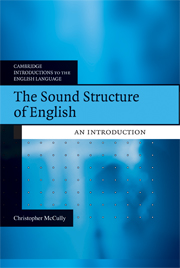Book contents
- Frontmatter
- Contents
- List of figures
- Acknowledgements
- A note on using this book
- 1 Introduction
- 2 Consonants (1): contrastiveness
- 3 Consonants (2): classification
- 4 Consonants (3): distribution
- 5 Syllables (1): introduction
- 6 Syllables (2): constituents
- 7 Syllables (3): structure
- 8 Vowels (1): short vowels
- 9 Vowels (2): long vowels and diphthongs
- 10 Vowels (3): variation
- 11 Problems, theories and representations
- Appendix: the IPA chart
- Glossary
- References
- Index of topics
- References
1 - Introduction
Published online by Cambridge University Press: 05 June 2012
- Frontmatter
- Contents
- List of figures
- Acknowledgements
- A note on using this book
- 1 Introduction
- 2 Consonants (1): contrastiveness
- 3 Consonants (2): classification
- 4 Consonants (3): distribution
- 5 Syllables (1): introduction
- 6 Syllables (2): constituents
- 7 Syllables (3): structure
- 8 Vowels (1): short vowels
- 9 Vowels (2): long vowels and diphthongs
- 10 Vowels (3): variation
- 11 Problems, theories and representations
- Appendix: the IPA chart
- Glossary
- References
- Index of topics
- References
Summary
In this chapter …
In this chapter we explore a system for thinking about, and then describing, English speech sounds. We will see that there are important differences between the usual written system of English and how the system of sounds is structured – so many differences, in fact, that the familiar written system of English could never be used as a transcription of either the structure that lies behind speech or the occurrence of English speech sounds themselves. As we'll see, in order to work systematically with the sounds of English we need to analyse both the structure that lies behind speech (we call this phonology) and the nature and occurrence of speech sounds themselves (we call this phonetics).
Here, too, we begin to look at some of the principles that govern phonology: the distribution of sounds, and how they contrast. We draw an analogy between this system and the system, or timetable, of trains, and see that to study phonology is to study part of the ‘timetable of language’.
Written and spoken English
It's critical for our purposes to distinguish between the written and the spoken systems of English.
- Type
- Chapter
- Information
- The Sound Structure of EnglishAn Introduction, pp. 1 - 18Publisher: Cambridge University PressPrint publication year: 2009

